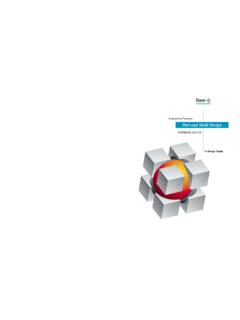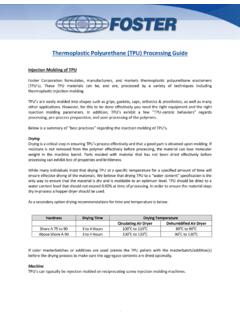Transcription of Extrusion Die Design and Simulation - Theseus
1 1 Simulation and Design of Extrusion Dies Kirubel Bogale Degree Thesis Plastics Technology 2011 2 3 DEGREE THESIS Arcada Degree Programme: Plastics Engineering Identification number: 9609 Author: Kirubel Bogale Title: Extrusion Die Design and Simulation Supervisor (Arcada): Mathew Vihtonen Commissioned by: Abstract: The aim of this engineering thesis was to Design and simulate a die for a rectangular pro-file. The project consisted of studying melt flow characteristics of plastics and how the die structure should be set in order to get the desired shape. After the die has been de-signed on 3D Solid edge Design software it was simulated on COMSL flow Simulation software. On the Simulation software it was easy to study how the melt flows and in which part of the die is the shear stress and strain strong and weak.
2 The drag flow and pressure flow were then extracted from the screw parameters which lead into the calculation of the operation point and the operating pressure for the die. It was also possible to calculate the mass flow rate and the velocity drop. And finally die optimization of die profile for rectangular shape was done. Keywords: Extrusion , Comsol, Solid edge, flow rate, output, density operating point, Die Design , Viscosity Number of pages: Language: English Date of acceptance: 4 TABLE OF CONTENTS 1 INTRODUCTION .. 10 Background .. 10 Objective .. 11 2 Literature Survey .. 12 Extrusion .. 12 Types of Extrusion .. 13 Extrusion Process and Operation .. 13 Single screw .. 14 Mechanism of Flow .. 14 Die Design .
3 16 Pressure Gauges .. 17 Heating Elements .. 18 Cost .. 19 Die land .. 20 Polymeric Melt Behavior .. 21 Rheology .. 21 Viscoelastic Fluid 22 Non-Newtonian Fluid Behaviour .. 23 Melt Behavior .. 24 Density .. 25 Melt Density .. 25 Bulk Density .. 26 Balance Equations .. 26 Momentum Balance Equations .. 26 Energy Balance Equations .. 27 Mass Balance Equations .. 27 Flow Analysis .. 28 Drag Flow .. 28 Pressure Flow .. 28 Shear Rate .. 29 5 Shear Strain .. 29 Shear Stress .. 29 Flow Models .. 30 Newtonian and non-Newtonian Fluids .. 30 Newtonian Fluids .. 30 Non-Newtonian Fluids .. 31 Power Law Model .. 32 Drag and Pressure flows .. 33 Flow analysis .. 34 3 Method .. 36 Die Modeling .. 36 Extruder line calculation.
4 39 Die characteristic for rectangular channel .. 41 Subdomain settings .. 42 4 Results .. 45 Post processing .. 45 5 Conclusion .. 53 6 References .. 54 Appendix .. 56 6 Figures Figure 1 Definition and Principle of Extrusion .. 12 Figure 2 Extrusion Process and .. 13 Figure 3. Flow coefficient as a function of channel geometry .. 16 Figure 4. Standard mica band heaters .. 18 Figure 5. Effect of die orifice shape on a square extrudate .. 20 Figure 6. Rheological models .. 21 Figure 7. Newtonian Fluids .. 30 Figure 8. Viscosity - Shear rate curve for some common plastics .. 33 Figure 9. Solid Edge modeling of the Die .. 36 Figure 10. Metric Draft of the Die .. 37 Figure11. Die detailed drawing .. 38 Figure 12. Die inlet area .. 43 Figure 13.
5 Die outlet area .. 43 Figure 14 Velocity curve at .. 45 Figure 15 Pressure curve .. 46 Figure 16. Pressure distribution in the die at .. 48 Figure 17. Shear rate curve at .. 49 Figure 18. Dynamic Viscosity Curve .. 50 Figure 19. Uneven stress distribution at the corners .. 51 Figure 20. Optimized die geometry .. 52 7 Tables Table 1. Density and melting points of some common plastics .. 25 Table 2. Power law parameters for some common plastics .. 32 Table 3. Extruder operating points .. 42 Table 4. Subdomain settings for LDPE .. 42 8 Nomenclature P = pressure (N) Qd = Drag flow (m3/s) Qp = Pressure flow (Pa) N = Screw revolution (rpm) H = Channel depth of the screw (m) = Helix angle of screw L = length of the screw (m) D = diameter of the screw (m) R = die radius (m) Ld = length of the die (m) = viscosity ( ) = Shear rate (S-1) = Shear stress n = Power law index Oop = Operating point Pop = Pressure at the operating point (Pa) = Melt density (kg/m3) = Mass flow rate 9 Glossary Viscosity: describes a fluid that is thick, sticky and does not flow easily Viscoelastic: a plastic melt having both viscous and elastic properties Thermoplastics: polymers that turns to liquid when heated and solidifies when cooled Pressure flow.
6 The flow of the polymer melt caused by pressure difference Shear stress: tangential force divided by area Shear rate: Velocity gradient measured in s-1 Shear thinning: reduction of viscosity as shear rate increases Shear thickening: describes a fluid with increasing viscosity as shear rate increases 10 1 INTRODUCTION Background One of the keys to successful profile Extrusion is combining good profile cross sectional designs with good die Design . Frequently, die Design for profile Extrusion is done using trial and error methods in-house by the company producing the profile. A good die de-signer can machine the correct die shape to produce the specified profile in three to four die cuttings or modifications, while an inexperienced die designer may have to machine seven to eight dies to obtain the desired profile.
7 Some companies specialize in comput-er-aided die designs based on computer modeling. With the desired profile cross section defined, the rheological parameters (viscosity versus shear rate, extension modulus and flow modulus) for the resin and the throughput rate, computer programs can Design the die cross section required, while predicting the pressure drops, melt temperature, and flow profiles within the die. Richardson [1] The die has to be properly designed to have uniform flow and pressure drops in all the legs of the profile. Improperly designed dies can lead to severe warpage problems asso-ciated with the profiles. Higher polymer flow rates in one section of the die compared to another will result in different molecular orientation. This causes different shrinkage characteristics from one section to the other.
8 Melt temperature in all channels needs to be similar to prevent one profile section from being hotter than another. This can lead to differential cooling outside the die and differential shrinkage and warpage. Another fac-tor that can lead to warpage in the final part is different molecular packing in one part of the die versus another, attributed to higher die pressure in one area compared to another. Part areas with higher molecular packing produce less shrinkage compared to other part sections. These factors are normally grouped under a general heading of internal stresses in the final part. And non uniform internal stresses can cause warpage in the final profile because the shrinkage is different between one profile sections relative to another.
9 Richardson [1] 11 Objective The main objectives of this thesis are 1. To Design a die using a Solid Edge modeling software for a rectangular profile. 2. To simulate the flow of polymers in the die using Comsol. 3. To calculate the output mass flow rate and the operating point of the die. 12 2 LITERATURE SURVEY Extrusion One of the most outstanding features of plastics is the ease with which they can be processed. In some cases semi-finished articles such as sheets or rods are produced and subsequently fabricated into shape using conventional methods such as welding or machining. In the majority of cases, however, the finished article, which may be quite complex in shape, is produced in a single operation.
10 The processing stages of heating, shaping and cooling may be continuous ( production of pipe by Extrusion ) or a re-peated cycle of events ( production of a telephone housing by injection moulding) but in most cases the processes may be automated and so are particularly suitable for mass production. There is a wide range of processing methods which may be used for plastics. In most cases the choice of methods is based on the shape of the component and whether it is thermoplastic or thermosetting. It is important therefore that through-out the Design process, the designer must have a basic understanding of the range of processing methods for plastics since an ill-conceived shape of Design detail may limit the choice of moulding methods. Crawford [2] Extrusion is a plastic deformation process in which a block of billet is forced to flow by compression through the die opening of a smaller cross-sectional area.











